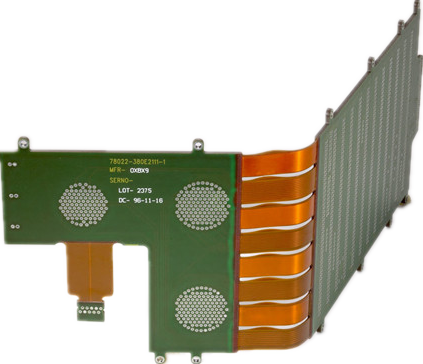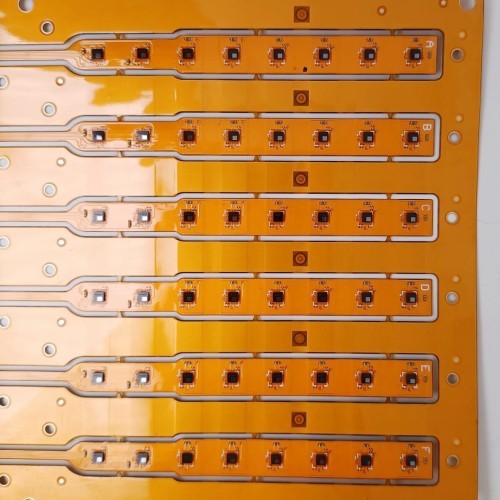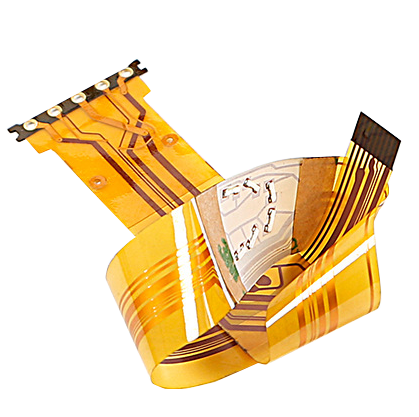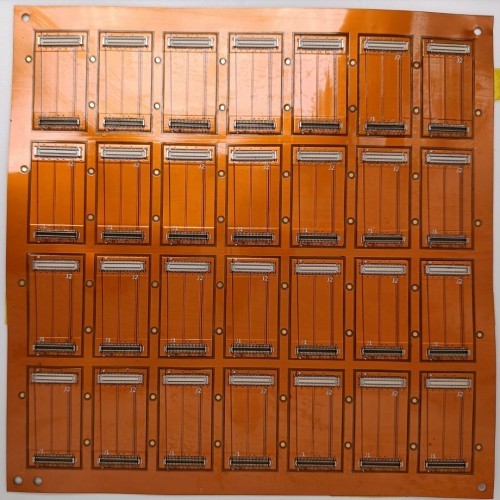Don't wanna be here? Send us removal request.
Text

Flex PCB Assembly
Flex PCB assembly refers to the process of soldering electronic components onto a flexible printed circuit board. This assembly process demands specialized techniques and equipment to ensure that components adhere properly to the flexible substrate.
0 notes
Text
FPC assembly is the process of populating and soldering electronic components onto a flexible printed circuit board (FPC). It involves precision and care to maintain the flexibility of the board while ensuring proper electrical connections.
0 notes
Text

A flex PCB prototype is a sample or early version of a flexible printed circuit board. Prototyping is a crucial step in the design and development process, allowing engineers to test and refine their designs before mass production.
0 notes
Text
Unraveling the World of Flex Circuit Prototypes: Choosing the Right FPC Manufacturer
Introduction
Flex Printed Circuit Boards (Flex PCBs), often referred to as Flex Circuits, have become indispensable in today's electronics industry. These bendable and versatile circuit boards are a crucial component in various applications, from medical devices and aerospace systems to consumer electronics. When it comes to designing and producing Flex PCB prototypes, choosing the right FPC manufacturer is paramount. In this blog post, we will explore the world of Flex Circuit Prototypes and discuss the key considerations when selecting an FPC manufacturer.

Understanding Flex Circuit Prototypes
Flex Circuit Prototypes are specialized printed circuit boards designed to be flexible, allowing them to conform to intricate shapes or fit into compact spaces. These boards are typically made from flexible substrates like polyimide (PI) or polyester (PET) and can have single or multiple layers, depending on the complexity of the circuit. Flex circuits can be found in products ranging from smartphones and wearable devices to automotive control systems.
Why Choose Flex Circuit Prototypes?
Space Efficiency: Flex PCBs are ideal for applications with space constraints, as they can be folded or bent to fit into tight spaces, reducing the overall size of the device.
Reliability: Flex circuits offer excellent reliability due to their reduced number of interconnects, which minimizes the risk of connection failures and short circuits.
Weight Reduction: Flex circuits are lightweight, making them a preferred choice in applications where weight reduction is critical, such as aerospace and automotive industries.
Durability: These circuits are more robust and can withstand vibrations and shock, making them suitable for applications that experience harsh environments.
Click here for more information: https://www.tumblr.com/fpcway/731599943480000512/exploring-fpc-assembly-flex-pcb-material-and
#Flex PCB#Flex Circuit Prototype#FPC Manufacturer#Flex PCB Material#FPC Prototype#Flexible Printed Circuit
0 notes
Text
Exploring FPC Assembly, Flex PCB Material, and Rigid-Flex PCBs
Introduction
In today's rapidly evolving world of electronics, the demand for smaller, more flexible, and highly integrated electronic devices is on the rise. To meet this demand, engineers and manufacturers are turning to innovative solutions like Flexible Printed Circuit (FPC) assembly, Flex PCB materials, and Rigid Flex PCB. These technologies are revolutionizing the way we design and produce electronic devices, allowing for greater flexibility and reliability. In this blog post, we will delve into these three key aspects of modern electronics and explore their applications and advantages.

FPC Assembly: The Foundation of Flexible Electronics
Flexible Printed Circuit (FPC) assembly, also known as Flexible Electronics Assembly, is a manufacturing process that involves using flexible materials and techniques to create electronic circuits that can bend and conform to various shapes. This technology is rapidly gaining popularity due to its numerous advantages:
a. Space Efficiency: FPCs are incredibly thin and lightweight, making them ideal for space-constrained applications where traditional rigid PCBs cannot fit.
b. Improved Reliability: FPCs reduce the risk of mechanical failures, such as solder joint cracking, which is common in rigid PCBs subject to bending or vibration.
c. Flexibility: FPCs can be folded, twisted, and bent, making them suitable for wearable devices, curved displays, and other innovative designs.
d. Cost-Effective: FPC assembly can often reduce the need for additional connectors and cables, saving on material costs and simplifying the assembly process.
Flex PCB Material: The Building Blocks of Flexibility
The choice of Flex PCB material is critical in achieving the desired flexibility and performance in electronic devices. Flexible PCBs are typically made from a variety of materials, including polyimide (PI), polyester (PET), and polyethylene terephthalate (PET), with PI being the most common choice.
Click here for more information: https://www.tumblr.com/fpcway/730768523049205760/the-evolution-of-electronics-flexible-printed
1 note
·
View note
Text
The Flexible Future of Electronics: Exploring Flexible Circuit Boards
Introduction
In the fast-paced world of electronics, innovation is the name of the game. As our devices become smaller, more powerful, and increasingly integrated into our daily lives, the demand for flexible and adaptable solutions has grown exponentially. One of the key enablers of this revolution is the flexible circuit board, also known as a flexible PCB board or flex circuit PCB. In this blog post, we will dive into the world of flexible circuit boards, exploring what they are, how they work, and their myriad applications across various industries.

Understanding Flexible Circuit Boards
A flexible circuit board, or flex circuit PCB, is a specialized type of printed circuit board that offers a unique advantage over traditional rigid PCBs – flexibility. While traditional PCBs are typically made from rigid materials like fiberglass or epoxy, flex PCBs are built using flexible materials such as polyimide (PI), polyester (PET), or even a combination of both. This flexibility allows them to be bent, folded, or contoured to fit the specific requirements of a given application.
How Do Flexible Circuit Boards Work?
The basic structure of a flexible circuit board is similar to that of a rigid PCB, consisting of conductive traces, pads, and components. However, the key difference lies in the substrate material. Instead of a rigid substrate, flex PCBs use a flexible material that can withstand repeated bending and flexing without compromising the integrity of the circuit.
Flex PCBs are typically manufactured using a combination of additive and subtractive processes. The process involves printing or etching the conductive traces onto the flexible substrate and then adding the necessary components. The result is a lightweight and compact circuit board that can be shaped to fit the available space.
Applications of Flexible Circuit Boards
Consumer Electronics: Flexible circuit boards are widely used in smartphones, tablets, and wearables. Their flexibility allows for unique form factors and more robust, durable designs.
Automotive Industry: In vehicles, flex PCBs are used in airbags, navigation systems, and instrument clusters. They can withstand the vibrations and temperature fluctuations common in automotive environments. Medical Devices: Flexible circuit boards are crucial in medical devices like pacemakers and medical imaging equipment. Their compact size and flexibility make them ideal for implantable and portable devices.
Click here for more information: https://www.tumblr.com/fpcway/730881884594241536/exploring-the-world-of-rigid-flex-circuit-boards
0 notes
Text
Exploring the World of Rigid-Flex Circuit Boards and Flex PCB Prototypes
Introduction
In the ever-evolving world of electronics, innovation is the name of the game. With a constant demand for smaller, more efficient, and versatile electronic devices, manufacturers are continually pushing the boundaries of what's possible. One significant development in this field is the use of flexible printed circuits (FPCs), rigid-flex PCBs, and the intricate process of flex PCB assembly. In this blog post, we will explore these cutting-edge technologies, their applications, and the rigid flex PCB manufacturer behind them.

Flexible Printed Circuits (FPCs)
Flexible printed circuits, often referred to as FPCs or flex circuits, are a vital component in modern electronic devices. They offer a flexible alternative to traditional rigid PCBs, making them ideal for applications where space and weight are at a premium. FPCs are constructed using flexible base materials, typically polyimide, and are designed to be thin and lightweight. Here are some key advantages of FPCs:
Space Efficiency: FPCs can be bent and folded to fit into tight spaces, making them invaluable in compact electronic designs.
Weight Reduction: Since FPCs are lightweight, they help reduce the overall weight of electronic devices, a critical consideration in industries like aerospace and automotive.
Reliability: FPCs are known for their high reliability due to the absence of connectors and the reduced risk of solder joint failure.
Complex Shapes: They can be designed in intricate shapes to accommodate specific device designs, which is often challenging with rigid PCBs.
Flexibility: FPCs can withstand millions of flex cycles without compromising their functionality, making them suitable for applications with moving parts.
Rigid-Flex PCBs
Rigid-flex PCBs are a hybrid solution that combines the benefits of both rigid and flexible circuits. They consist of multiple layers of flexible substrates interconnected with rigid PCB sections. This combination allows for complex three-dimensional designs, improved reliability, and reduced assembly time.
Click here for more information: https://www.tumblr.com/fpcway/730768523049205760/the-evolution-of-electronics-flexible-printed
0 notes
Text
The Evolution of Electronics: Flexible Printed Circuits, Rigid-Flex PCBs, and Flex PCB Assembly
Introduction
In the ever-evolving world of electronics, innovation is the name of the game. With a constant demand for smaller, more efficient, and versatile electronic devices, manufacturers are continually pushing the boundaries of what's possible. One significant development in this field is the use of flexible printed circuits (FPCs), rigid-flex PCBs, and the intricate process of flex PCB assembly. In this blog post, we will explore these cutting-edge technologies, their applications, and the rigid flex PCB manufacturer behind them.

Flexible Printed Circuits (FPCs)
Flexible printed circuits, often referred to as FPCs or flex circuits, are a vital component in modern electronic devices. They offer a flexible alternative to traditional rigid PCBs, making them ideal for applications where space and weight are at a premium. FPCs are constructed using flexible base materials, typically polyimide, and are designed to be thin and lightweight. Here are some key advantages of FPCs:
Space Efficiency: FPCs can be bent and folded to fit into tight spaces, making them invaluable in compact electronic designs.
Weight Reduction: Since FPCs are lightweight, they help reduce the overall weight of electronic devices, a critical consideration in industries like aerospace and automotive.
Reliability: FPCs are known for their high reliability due to the absence of connectors and the reduced risk of solder joint failure.
Complex Shapes: They can be designed in intricate shapes to accommodate specific device designs, which is often challenging with rigid PCBs.
Flexibility: FPCs can withstand millions of flex cycles without compromising their functionality, making them suitable for applications with moving parts.
Rigid-Flex PCBs Rigid-flex PCBs are a hybrid solution that combines the benefits of both rigid and flexible circuits. They consist of multiple layers of flexible substrates interconnected with rigid PCB sections. This combination allows for complex three-dimensional designs, improved reliability, and reduced assembly time.
0 notes
Text

Flex PCB Assembly
Flex PCB assembly refers to the process of soldering electronic components onto a flexible printed circuit board. This assembly process demands specialized techniques and equipment to ensure that components adhere properly to the flexible substrate.
0 notes
Text
Flex PCB Assembly
Flex PCB assembly refers to the process of soldering electronic components onto a flexible printed circuit board. This assembly process demands specialized techniques and equipment to ensure that components adhere properly to the flexible substrate.
1 note
·
View note